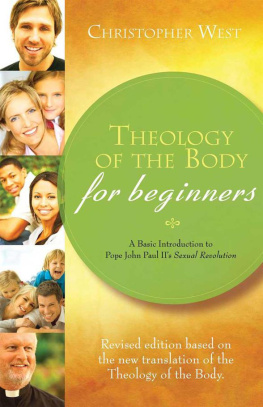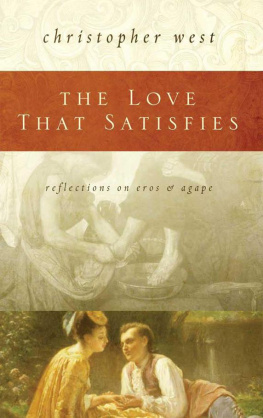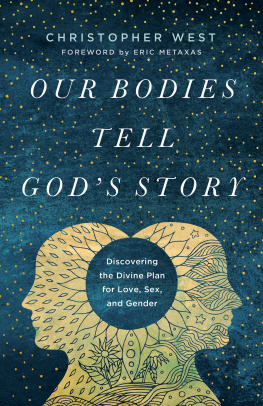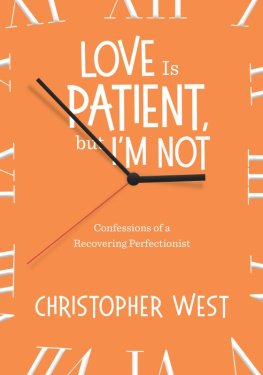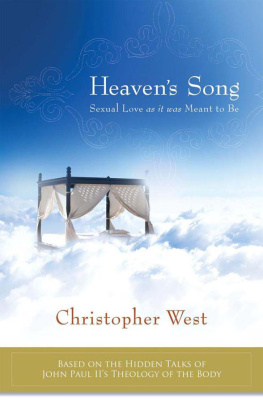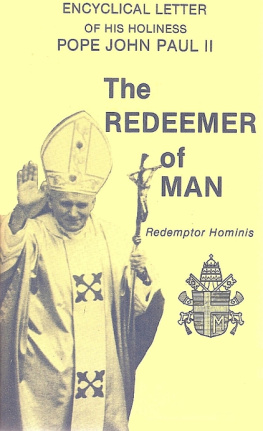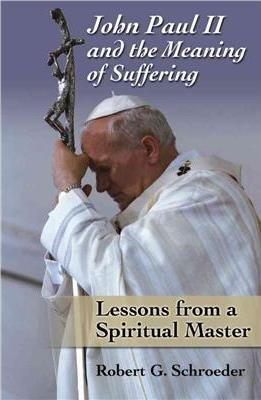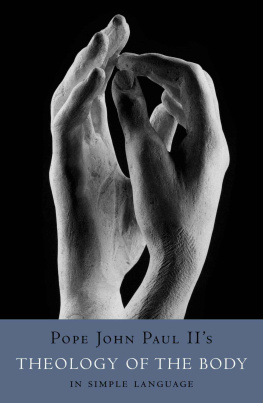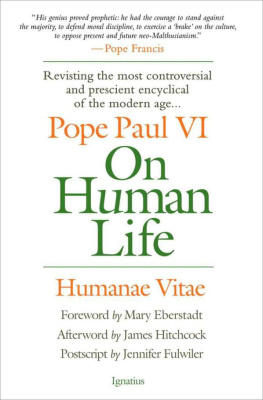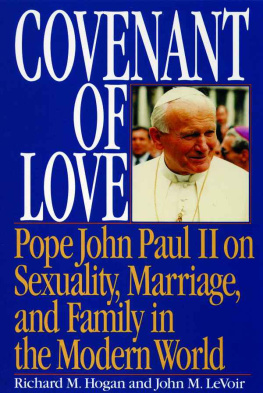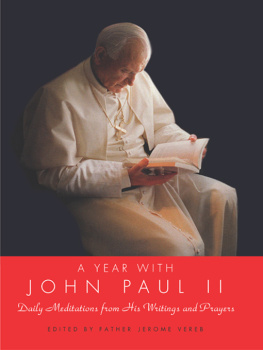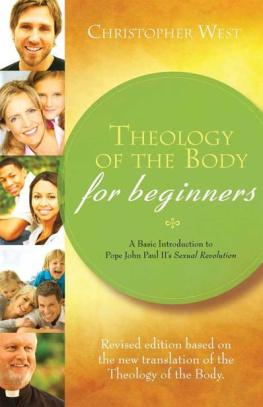
A Basic Introduction to
Pope John Paul IIs Sexual Revolution
Christopher West
West Chester, Pennsylvania
Nihil obstat: Rev. J. Brian Bransfield, STD
Censor Librorum
March 10, 2008
Imprimatur: +Justin Cardinal Rigali
Archbishop of Philadelphia
March 19, 2008
Copyright 2004, 2009 Christopher West. All rights reserved.
With the exception of brief excerpts in critical reviews, no part of this work may be reproduced in any form whatsoever, printed or electronic, without the prior written consent of the publisher.
All Scripture quotations contained herein are taken from the Revised Standard Version of the Bible, copyright 1946, 1952, and 1971 by the Division of Christian Education of the National Council of Churches of Christ in the USA. Used by permission.
Published by Ascension Press
Post Office Box 1990
West Chester, PA 19380
Orders: 1-800-376-0520
www.AscensionPress.com
Cover design: Devin Schadt
Printed in the United States of America
10 11 12 13 9 8 7 6 5 4 3 2
ISBN 978-1-934217-85-6
Abbreviations
CCC Catechism of the Catholic Church , second edition (Libreria Editrice Vaticana, 1997)
DV Dominum et Vivificantem , John Paul IIs encyclical letter on the Holy Spirit (Pauline, 1986)
EV Evangelium Vitae , John Paul IIs encyclical letter on the Gospel of Life (Pauline, 1995)
FC Familiaris Consortio , John Paul IIs apostolic exhortation on the Christian Family (Pauline, 1981)
FR Fides et Ratio , John Paul IIs encyclical letter on Faith and Reason (Pauline, 1998)
GS Gaudium et Spes , Vatican IIs Pastoral Constitution on the Church in the Modern World (Pauline, 1965)
HV Humanae Vitae , Pope Paul VIs encyclical letter concerning Human Life (Pauline, 1968)
LF Letter to Families , John Paul IIs letter in the Year of the Family (Pauline, 1994)
LG Lumen Gentium , Vatican IIs Dogmatic Constitution on the Church (Pauline, 1964)
LR Love and Responsibility , Karol Wojtylas (John Paul IIs) philosophical work on sexuality (Ignatius Press, 1993)
MD Mulieris Dignitatem , John Paul IIs apostolic letter on the Dignity and Vocation of Women (Pauline, 1988)
NMI Novo Millennio Ineunte , John Paul IIs apostolic letter at the Close of the Jubilee Year (Pauline, 2001)
OL Orientale Lumen , John Paul IIs apostolic letter on the Light of the East (Pauline, 1995)
RM Redemptoris Missio , John Paul IIs encyclical letter on the Mission of the Redeemer (Pauline, 1990)
RH Redemptor Hominis , John Paul IIs encyclical letter on the Redeemer of Man (Pauline, 1979)
SE Springtime of Evangelization: John Paul IIs 1998 ad limina addresses to the Bishops of the United States (Basilica Press, 1999)
TOB Man and Woman He Created Them: A Theology of the Body , John Paul IIs general audience addresses on Human Love in the Divine Plan (Pauline, 2006)
VS Veritatis Splendor , John Paul IIs encyclical letter on the Splendor of Truth (Pauline, 1993)
WH Witness to Hope , George Weigels biography of Pope John Paul II (HarperCollins, 1999)
I NTRODUCTION
In January of 2004, Time magazine opened a sixty-page spread on the issue of human sexuality with an article that, even though written from a secular perspective, asked some of the right questions:
Of all the splendidly ridiculous, transcendently fulfilling things humans do, it is sex ... that most confounds understanding. What in the world are we doing? Why in the world are we so consumed by it? The impulse to procreate may lie at the heart of sex, but ... bursting from our sexual center is a whole spangle of other thingsart, song, romance, obsession, rapture, sorrow, companionship, love, even violence and criminalityall playing an enormous role in everything from our physical health to our emotional health to our politics, our communities, our very life spans. Why should this be so? Did nature simply overload us in the mating department...? Or is there something smarter and subtler at work, some larger interplay among sexuality, life and what it means to be human? ( Time , Jan 19, 2004, p. 64).
This something smarter at work, that larger interplay among sexuality, life, and what it means to be human is precisely what John Paul II explored in great depth and with penetrating insight in his Theology of the Body.
The late Popes Theology of the Body is creating quite a buzz in the Church today. In fact, it has already begun what many are calling a sexual counter-revolution. It is spreading and it cannot be stopped. Still, for the vast majority of Christians, the content of John Pauls teaching remains an untapped treasure. Why? As papal biographer George Weigel observes, The density of John Pauls material is one factor; a secondary literature capable of translating John Pauls [Theology of the Body] into more accessible categories and vocabulary is badly needed (WH, p. 343).
My book Theology of the Body Explained (revised edition, 2007) provides a thorough, 600-page commentary on John Paul IIs revolutionary teaching on the body and sexual love. While this work manages to unfold the Popes insights and make them more accessible, its sheer size and more academic style can still intimidate the average person. As I wrote in the preface to Theology of the Body Explained , smaller-scale efforts are also needed. In response to that need, I humbly present this short introduction.
The first edition of this book, which was released in 2004, was based on the English text of the Theology of the Body translated by the Vatican newspaper LOsservatore Romano. This newly-revised edition is based on the much improved critical edition of the Theology of the Body, translated by Dr. Michael Waldstein and published by Pauline Books and Media (2006).
In addition to providing a more coherent and faithful translation of John Pauls teaching, Waldstein unearthed several undelivered addresses in the Theology of the Body series and translated them into English for the very first time. Waldstein also inserted the Popes original headings and chapter divisions into the text, allowing us to understand John Pauls train of thought in new ways. All of this called for both a revised edition of both my commentary and my beginners book (which you now hold in your hands).
Those looking for a theologically sophisticated treatment of John Paul IIs thought should turn to other resources and commentaries. My goal here, as the title indicates, is to simplify the Theology of the Body for beginners. After laying an important foundation in chapter one, I outline in chapters two through eight the main ideas of the Popes teaching according to the structure of his original manuscript. Chapter nine provides some concluding thoughts on the role of the Theology of the Body in the new evangelization. I also include a glossary that not only offers definitions of key terms and phrases for quick reference, but also serves as a summary of the book itself. Finally, the resource section lists organizations that you can contact to learn more about the Theology of the Body.
As you proceed, keep in mind that popularizing John Paul IIs Theology of the Body is virtually uncharted territory. Finding the best language, images, and anecdotes with which to do so is a difficult task and remains a work in progress. While my goal, of course, is to convey the essentials of the Popes teaching, I cannot help but deliver it through my own filter. As does every interpreter of John Pauls work, I bring my own personal perspectives, gifts, and shortcomings to the table. As St. Paul says, Test everything; hold fast to what is good (1 Thessalonians 5:21).
I pray that this book helps open a new world for you. Indeed, if we take John Paul IIs sexual revolution to heart, we will never see ourselves and the universe quite the same way again.
Next page
